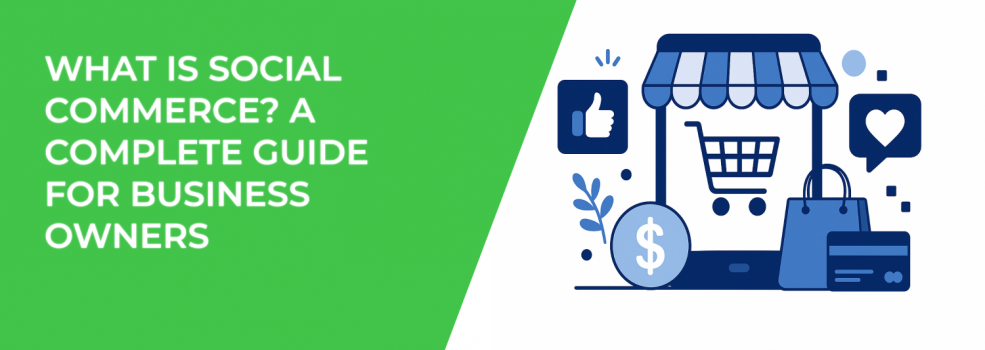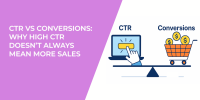If you’re running ads or managing campaigns, you’ve probably heard the term social commerce. But what does it really mean? And how can it grow your business?
This guide breaks it down step by step. You’ll learn what social commerce is, why it matters, and how to use it in a way that delivers results.
What Is Social Commerce?
Social commerce is selling directly inside social media platforms. Instead of sending people to a separate website, the buying process happens within the app.
Imagine this: someone scrolling Instagram sees a tagged product, taps it, and checks out without leaving their feed. Or think of a TikTok live where viewers ask questions about a product and then buy it in real time. That’s social commerce.
It blends discovery and checkout in one place. People see something they like, interact with it, and buy — all in the same moment.
Why Social Commerce Matters
Why should business owners and advertisers care? Because it shortens the customer journey and removes friction.
-
Customers don’t have to leave the app, so fewer drop-offs happen.
-
Social proof — likes, comments, and shares — builds trust instantly.
-
Mobile-first experiences convert better than outdated web pages.
And let’s be real: people already spend hours a day on social apps. If shopping is built into their routine, you want your brand in the mix.
If your ads aren’t converting the way you expect, adding social commerce can be a game changer. It often works best when paired with the right targeting strategy. If you’re struggling to define your audience, check out this step-by-step guide to defining a target audience.
Social Commerce vs. Traditional Ecommerce
Traditional ecommerce takes place on websites. Social commerce happens directly inside social apps. The difference is all about the path to purchase.
In ecommerce, the buyer clicks an ad, loads a website, adds items to a cart, and then checks out. In social commerce, they move from content to purchase in one place. It feels faster, simpler, and more natural.
Websites are still important, but social commerce is quickly becoming an essential extension of the sales funnel.
Key Features and Formats
Social commerce isn’t one single feature. Platforms have added different tools to make shopping part of the scrolling experience.
Some of the most useful include:
-
Shoppable posts and stories. Products can be tagged in photos or videos so buyers tap and buy instantly.
-
Live shopping. Brands or influencers host a live stream, answer questions, and sell in real time.
-
In-app storefronts. Platforms like Instagram Shops or TikTok Shop let you create mini catalogs inside the app.
-
Influencer-driven sales. Creators promote products in their content, giving followers a direct path to buy.
These formats all aim to remove barriers and make shopping easier.
Which Platforms Lead the Way?
Not every platform is equally advanced, so it’s smart to focus where your customers already spend time.
Facebook and Instagram have strong tools, from product tags to shops. TikTok is exploding with younger audiences and impulse-driven products. Pinterest works well for discovery-led shopping.
YouTube and Snapchat are testing new options, especially for Gen Z. But for most businesses, the big three — Instagram, TikTok, and Facebook — are the best starting points.
If you’re leaning toward Facebook, make sure your setup is solid. A good place to start is learning about Facebook Shops and how to set one up for sales.
How to Build a Strategy That Works
Many brands make the mistake of turning on features without building a plan. To succeed, you need strategy, creative execution, and data-driven adjustments.
-
Match your product to the format. Lower-priced, eye-catching items often work best in quick, shoppable content. High-ticket products may need storytelling or live sessions.
-
Create content that feels natural. Skip stiff ads. Use product demos, unboxings, or clips from real customers. Posts are your storefront — make them feel real.
-
Use your data. Track conversion rates, order values, and drop-offs. Retarget people who clicked but didn’t buy. Adjust weekly, not months later.
Want help improving your campaigns? Start by reviewing your targeting. Here’s a guide on Facebook ad targeting basics that can also shape your social commerce approach.
What to Watch Out For
Jumping into social commerce without preparation can waste time and budget. Common mistakes include:
-
Spreading across too many platforms too quickly.
-
Uploading poor-quality catalogs or images.
-
Creating content that feels like traditional ads instead of native social posts.
Another pitfall is treating social commerce as separate from the rest of your marketing. It should work alongside your website, email campaigns, and offline efforts. Customers expect a consistent experience everywhere.
And don’t forget costs. Platforms often take fees. If your margins are thin, make sure the math works before scaling.
Getting Started in Simple Steps
-
Review your audience and products. Which platforms do they use most, and which products are best for quick, visual sales?
-
Pick one or two platforms. Focus on getting results there before expanding.
-
Set up your shop with high-quality images and clear, mobile-friendly descriptions.
-
Create content. Try shoppable posts, run a live stream, or partner with a micro-influencer.
-
Track results closely, adjust fast, and repeat what works.
Need help making your Facebook campaigns more efficient? Learn how to choose the right Meta ad objectives so your strategy aligns with your business goals.
Final Thoughts
Social commerce is reshaping how people shop. It combines discovery, trust, and buying into one smooth flow — and that creates big opportunities for business owners.
For advertisers and marketers, the key is to keep it simple: test small, create content that feels real, and make buying effortless. When you align your audience, platform, and content, you’ll see results that go beyond clicks.

